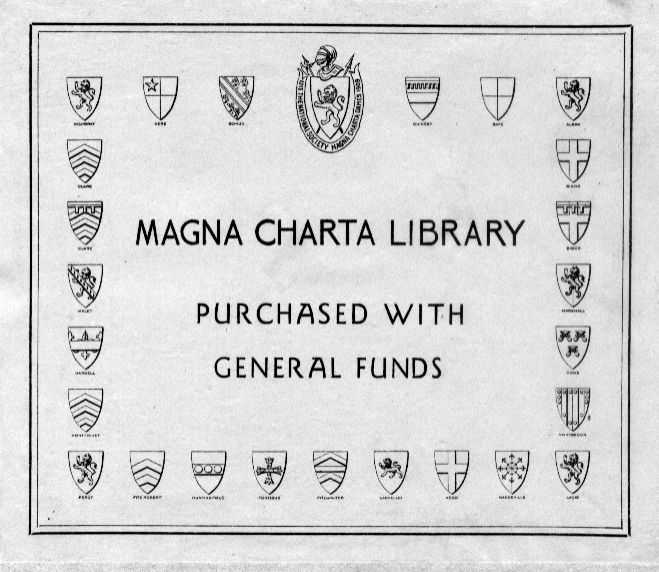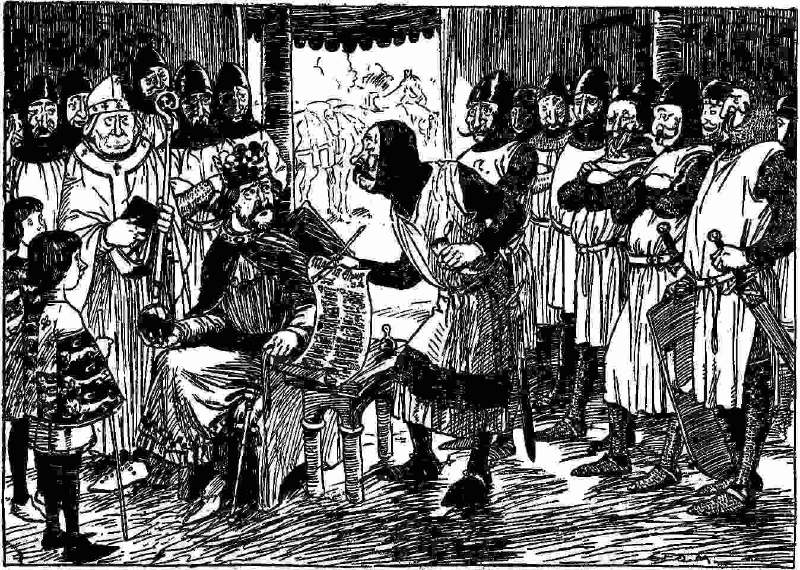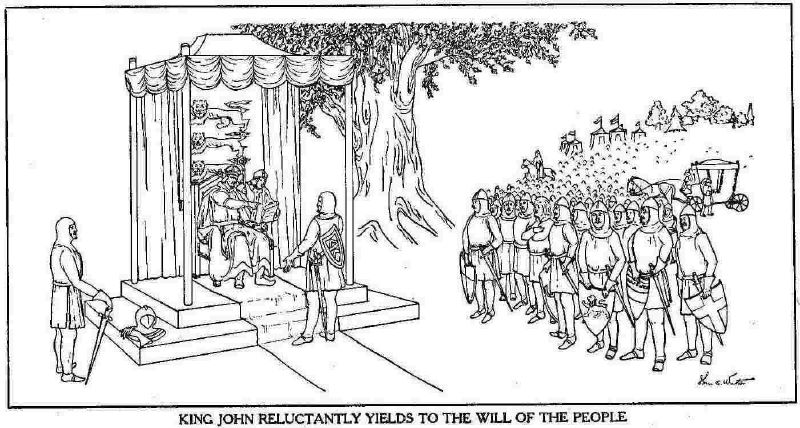I broke down and had my copy of James Anderson’s Royal Genealogies (second printing, 1735) rebacked five years ago, but told the binder to retain the interesting bookplate which was there when I bought it: the bookplate of the ‘Magna Charta Library’ of the ‘National Society Magna Charta Dames’. It has the arms of the Dames at center top, surrounded by the arms borne by the 25 sureties chosen to watch over and harrass the king should he renege on his various concessions (see clause 63 of the charter of 1215, where the king tells them what they can do to him).

Indeed, for some time after buying the book (from a crazy but lovable Harvard Square bookman) I had pangs of guilt. Was it pilfered from the library of such an organization? No, I learned while talking with Lewis Neilson, the group’s chancellor: long ago the organization had a headquarters with research library, but this (and perhaps all other assets) had dissolved during a long dormancy. I gather that the current group is something of a recent reanimation, which would fit with the ebb, then revival of genealogy in the United States over the past two generations. The upshot was that I should feel no guilt about possessing this institutional vestige.
And perhaps I should not have felt too guilty anyhow. The ‘National Society, Magna Charta Dames’ (founded in 1909) rode the same wave that had precipitated the founding of the D.A.R., as a group with the stated goal of patriotic commemoration and an unstated goal of social differentiation between established WASP settlers’ descendants and the great crush of unwashed after-comers: We could feel noble about welcoming the ‘huddled masses yearning to breathe free’, but we would hold ourselves above and apart. All the more for the Magna Charta dames: those who, finding their lines in the pages of Browning’s Americans of Royal Descent (1890) or Magna Charta (1898), could bask in the illusion that aristocratic ancestry was a rare and exclusive achievement, without sacrificing their veneration for the egalitarian theme of the American identity.
Medieval, but democratic
This same paradox lies at the root of the Magna Carta itself. Since the seventeenth century, this enigmatic document has been held up as a milestone in the development of the rights of Englishmen and the limitation of the absolutism of the English monarchy. This view of Magna Carta derives from the seventeenth-century lawyers who opposed the king in the years leading up to the bitter English Civil War, and it has been a commonplace ever since in American education and thought. Not too long ago, the pseudo-libertarian American politician Ross Perot bought a late thirteenth-century copy of Magna Carta, and loaned it for more or less permanent display in the U.S. National Archives, where it is enshrined near fair copies of the Declaration of Independence and the Constitution. It is ironic that this copy, like all post-1215 reissues of the charter, lacks the original clause 63, and thus contains no notice of any ‘sureties’ who are to safeguard subjects’ rights against the abuses of a wayward king. In contrast, one of the four extant copies of the Magna Carta of June 1215 toured the United States in the back of a custom semi-trailer along with the fair copy of our written Constitution, to celebrate the latter’s bicentennial in the late 1980s. So I saw the Lincoln Cathedral Magna Carta while hunched over inside a dimly lit trailer in a parking lot in New Bedford, Massachusetts.

[A late thirteenth-century reissue; I’m not sure which MS.
Photo widespread on the Net.]
If one asks cui bono—who benefits—from each of the many clauses of the Magna Carta it is quickly clear that most of the charter is irrelevant to the people generally. The charter has very little to do with the rights or protections of all people, generally speaking. It is a very specific laundry list of concessions made by a cornered king to a self-interested oligarchic party in open rebellion. This party consisted of many of the great barons of the realm, who were protesting against the encroachment of a burdensome centralized judicial and fiscal structure. The charter protects the financial independence and judicial autonomy of these great barons, who don’t have to pay so many feudal taxes (they only have to pay taxes, or ‘aids’, without their consent three times in a king’s life) and don’t have to reliquish the immensely profitable administration of private court systems on their own lands. King John—who is now understood as a very able administrator who developed key institutions within the nascent English government—was also a terribly unlucky ruler whose military and territorial losses drove him to seek to raise more and more money with creative zeal until the baronial oligarchy at last refused, imposing the charter on him.

Cartoon which appeared in Wurts’ Magna Charta, part 1, 1940
Elsewhere I’ve written about other remarkable medieval ancestor-groups—members of the ‘band of brothers’ who pulled off the long-odds victory at Agincourt in 1415, or popes, or troubadours, or Crusaders. Alone among all possible distinctive groups of medieval ancestors, sureties for the Magna Carta form the basis of a large lineage society in the United States. It is the misleading cachet of proto-democracy that has made these particular medieval ancestors important in the world of American lineage societies, where ‘patriotism’ goes hand-in-hand with pride in one’s own personal ancestry.

Cartoon, apparently drawn by John Wurts himself, appearing in part 1 of his Magna Charta, 1940
In fact there are currently three distinct Magna-Carta lineage societies in the United States, just as there are different flavors of ‘Colonial Dames’. The oldest was founded in 1898 as the ‘Order of Runnemede’, renamed the ‘Baronial Order of Magna Carta’ some decades later. This group is currently quite small, and now admits women as well as men. The ‘National Society Magna Charta Dames’, founded 1909, spun off a men’s auxiliary, the ‘Somerset Chapter Magna Charta Barons’, in 1932; in recent years this his-and-hers pair of socieities has been reborn as the ‘National Society Magna Charta Dames and Barons’, an organization which apparently has many more members than either the ‘Baronial Order of Magna Charta’, or the independent ‘Daughters of the Barons of Runnemede’. This last group, founded in 1921, may have been affiliated with the former ‘Order of Runnemede’, but is currently independent of the ‘Baronial Order of Magna Charta’: so women theoretically have a choice of three Magna-Carta related lineage societies to join: the ‘Magna Charta Dames’ of 1909, the Daughters of the Barons of Runnemede of 1921, and the Baronial Order of Magna Charta, originally the Order of Runnemede, of 1898. Confused yet? The two major groups do not work to alleviate the confusion, and one can compare them on line: the ‘Baronial Order of Magna Charta’ at http://www.magnacharta.com, and the ‘National Society Magna Charta Dames and Barons’ at http://www.magnacharta.org. What a domain war!
The duplication, potential confusion, and rivalry aside, the largest of these groups boasts a membership over ten thousand (self-reported to the Hereditary Society Blue Book), which—if true—presents a curiously large audience for this skewed slice of medieval history. Membership may soon include a cousin of mine, who has decided to join and asked me to help her out. I don’t think it appropriate to talk her out of it.
Sources on Magna Carta:
J. C. Holt, Magna Carta, 2d ed. (Cambridge University Press, 1992; 1st ed. 1965): still the definitive narrative and analysis of the charter.
J. C. Holt, Magna Carta and the Idea of Liberty (New York, 1972; reprinted Malabar, FL: Krieger, 1982). Collected essays on the interpretation of Magna Carta in the centuries since its creation: invaluable primer on the myth of Magna Carta.
Charles Henry Browning, The Magna charta barons and their American descendants with the pedigrees of the founders of the Order of Runnemede deduced from the sureties for the enforcement of the statutes of the Magna charta of King John (Philadelphia, 1898). A second edition was titled Magna charta barons and their descendants; with the story of the great charter of King John; sketches of the celebrated twenty-five sureties for its observance, and their lineal descents from them of the members of the baronial Order of Runnemede (Philadelphia, 1915; also reprinted Baltimore, 1969). Along with Browning’s earlier Americans of Royal Descent (Philadelphia, 1883 and later editions), these works mark the growth of pre-modern genealogical interest generally, and the birth of relevant lineage societies, in the United States.
John S. Wurts, Magna Charta, several volumes (Philadelphia, PA, 1940 and later). Derivative of Browning, and notable for its bad, pietistic prose (especially in Wurts’ 1939 dinner address to the Magna Charta Dames, printed as volume 1, part 1 of this series) and devotion to the myth of the charter.
Robert Edwin Bye, Magna Charta: King John and the Barons (Bridgeport, PA: Chancellor Press, for the Baronial Order of Magna Charta, 1966): better than its predecessors; a workmanlike and thorough genealogical account of the sureties and other people involved with the charter, reflecting conventional genealogical wisdom of its time.

One Trackback/Pingback
[…] I’ve written on some other American lineage societies based on medieval ancestry. Of all these groups—of questionable social, genealogical, or civic value—this Merovingian […]
Post a Comment